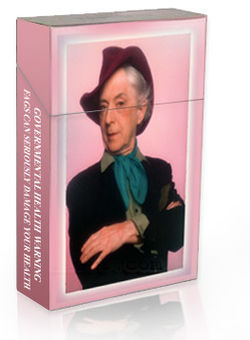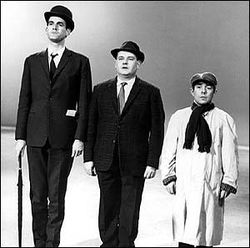Woodbines
“I always loved to smoke one at the back of the bike sheds...”
An early brand of cigarette, enjoyed by the labouring classes of Northern England from the 19th Century onwards, which many consider responsible for permanent genetic mutation to the vocal chords of those districts and the cause of their thick, impenetrable regional accents and gruff, animalistic voices. The famous "Woodbine Cough" can still be heard throughout the North of England and into parts of Southern Scotland, echoing around tenement slums in Manchester, Glasgow and Grimsby.
Ingredients[edit | edit source]
Woodbines are made of Asbestos, Coal dust and bitumen mixed with Tobacco wrapped in old newspaper. The "secret ingredient" remains a closely guarded corporate secret.
History[edit | edit source]
Development and Manufacture[edit | edit source]
Woodbines were produced as the result of the industrialist Frank Arthur Gary Woodbine’s visit to America in 1862 to study new methods of crushing the proletariat. It was while visiting Phillip Morris’s tobacco plantations in the Fall of that year that the idea for Woodbines was born.
Until this time, vital, nourishing tobacco - the only natural source of vitamin N – was only available from chemists in small tins or in the form of the expensive cigar. Woodbine realised that his work force, which was taking up to 30 trips to the local chemists per day, would become far more productive if they could take their tobacco while they worked.
During his visit to Virginia he discovered that the locals, who were too poor to buy pipes to smoke tobacco, wrapped their tobacco in old newspaper. By 1870 he had perfected his new invention, the cigarette, by crushing tobacco leaves and mixing them with asbestos, coal dust and bitumen he had created the first method of tobacco smoking which didn't require a pipe and was far cheaper than the cigar.
Product Launch[edit | edit source]
| “ | A packet of 20 Woodbines Full Strength Cigarettes is the ideal reason to carry matches! – Early advertising slogan | ” |
Woodbines were an instant success throughout the industrial heartlands of northern England and southern Scotland. Productivity in Woodbine’s mills rose 700%, more than compensating for the 300% rise in industrial accidents, and soon profits from the re-named Woodbines Cigarettes Ltd. dwarfed that of his other companies. The brand became a cultural icon from the start; on the 10th birthday children were given their first packet, and by the age of 15 most boys smoked four packets a day. Hospitals and chemists would give free packs to survivors of pit disasters, men who didn’t smoke at all were banished to the wastelands of Wales with only sheep for company.
The Golden Age[edit | edit source]
| “ | Britons Beware! Herr Hitler wants to take your Land, your King, and your Woodbines! – Advertising slogan c1940 | ” |
By the end of the 1910s, Woodbines were ubiquitous, with 50% of the population smoking at least 30 a day (except Sundays and Bank Holidays), and F. A. G. Woodbine was awarded several honours, including the Order of the Bath, the Iron Cross and the Florence Nightingale Medal. New products were launched, such as Women's Woodbines, which included di-fluorobenzachromate which gave a lavender-style taste and Miss Woodbines, marketed at schoolgirls. These were essentially the same as Women's Woodbines, but had small pictures of horses on the packet. This was the greatest era in the history of Woodbines, but paradoxically, it sowed the seeds of its downfall.
The “New Coke” Moment[edit | edit source]
| “ | Filtered Cigarettes: No Longer Only for Toffs! – Advert for Filtered Woodbines | ” |
Despite the remarkable success of Woodbines they were still only smoked by the labouring classes. The “lah-di-dah” demographic, with their fast cars, long fingers, and disposable incomes preferred other, newer brands, like Lambert & Butler, or Regals. These brands were seen as having an aura of sophistication and class. Market research by Woodbines Cigarettes Ltd. found that that most people associated the filter on these brands with refinement.
Woodbines Filters were launched in the summer of 1961, with limited success. Worse, previous addicts consumers of regular Woodbines were changing brands mostly to the even stronger Capstan Full Strength brand, feeling betrayed that “their” cigarettes had gone posh, and sold out its working class roots. It was in vain that Woodbines executives pointed out that the filters were, in fact, made of asbestos dipped in creosote. Regular gaspers smokers also complained that the filter interfered with the bitumen taste, and prevented the coal dust from entering the lungs. Although bored economic historians have guessed that the influx of cheap foreign competitors at this time caused as much harm, it was believed that this decision had wounded Woodbine Cigarettes Ltd. Sales slumped, profits nosedived and crucially the image of the product was tainted, perhaps beyond repair. F. A. G. Woodbine, now 157 years old, reacted firmly by ordering his entire marketing department to shoot themselves through the head. Although this caused a brief rise in popularity, the decline was only slowed, not halted. In 1965 Woodbine sold his company to W.D & H.O Wills and dropped dead as soon he received their cheque. After W.D & H.O Wills's took over they removed the filter and discontinued the by-then unpopular Women's Woodbines and Miss Woodbines brands. By the early 1970s Woodbines had become even more popular as doctors discovered that tobacco not only increases life-span but also prevents lung cancer and baldness.
The Present[edit | edit source]
These days, Woodbines are smoked mainly by the mill workers and miners who never abandoned the brand in the dark days of the 1960s, most of whom wear flat caps, knitted tank tops, braces and old brown macs and frequently own whippets. Other smokers include elderly women and teenagers.
Cultural Impact[edit | edit source]
Famous Smokers[edit | edit source]
- The Queen Mum, gawd bless ‘er, she smoked 80 a day
- Barbara Cartland
- Hugh Grant
- Shirley Bassey
- Dame Vera Lynn
- John Inman smoked 59 low-coal dust Woodbines a day, he dropped dead as soon as he gave up smoking
- Alec Douglas-Home
- Harold Macmillian
- Harold Wilson
- Sunny Jim
- George Formby smokes 40 full strength Woodbines every day
- Oscar Wilde We all love him, don't we!
The Arts[edit | edit source]
During the British National Anthem ("God kill Tony Blair"), the little known third verse consists of smoking a Woodbine. The Bolshoi Ballet requires that all dancers smoke at least 30 Woodbines a day.
Journalism[edit | edit source]
In newspapers in the north of England, a tactical error made by a large, seemingly all-conquering company is known as a “Filtered Woodbine” mistake, rather than a “New Coke” mistake.
Centre of Production[edit | edit source]
- F. A. G. Woodbine Asbestos distributers and Cigarettes producers Ltd,
- Number 42,
- Lungcancer Lane,
- Rochdale,
- Lancashire,
- England
If You Enjoy Woodbines, Why Not Try:[edit | edit source]
- Newcastle Brown Ale?
- Living in a Victorian terraced house?
- Arc-welding?
- New Coke?
- Eating coal?


